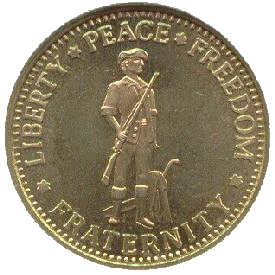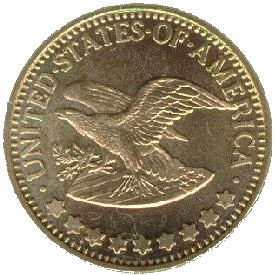
OBVERSE

REVERSE
Olin Brass Minuteman Patterns |
|
|
In the early 1990's, the subject of a new small size dollar coin arose again, resulting in a bill being introduced in the U.S. House of Representatives (H.R 1245) in 1991 which sought a circulating dollar coin and elimination of the $1 Federal Reserve Note. On November 6, 1991, representatives of Olin Brass Corporation of East Alton, Illinois, testified before a committee hearing on this matter. They handed out 28-30 of these pieces to the members and staff of the House Banking Subcommittee on Consumer Affairs and Coinage. Other pieces were handed out to members of the press and to The Coin Coalition, who was seeking production of a golden dollar coin. Although the exact number distributed is not known, due to Olin Brass's restrictive distribution, probably less than 100 pieces exist.
The biggest complaint against the Anthony Dollar was that it was too close in size and color to the Quarter Dollar. Olin Brass believed that a golden planchet with a plain edge would be more suitable for the dollar coin. They testified that these distinguishing characteristics would "help consumers and the visually handicapped quickly distinguish the dollar coin in a handful of change...." These metallurgical trial pieces were produced by Olin Brass to illustrate the characteristics a clad dollar could have and to test their electronic properties for use in vending machines. The planchets were produced by Olin Brass, and the pieces were struck by the Roger Williams Mint, a private minter. Olin Brass' purpose was to promote their alloy, not the Minuteman/Eagle design. They had these pieces struck because they felt that the pieces with designs were more effective in promoting their alloy than unstruck planchets.
The Minuteman metallurgical trial pieces were produced in two different alloys with slightly different color. Olin Brass officials described the composition as copper-based clad, preferring to keep the exact composition a secret. Besides being distinguishable by the color difference, one was struck with its dies oriented in "coin alignment" and the other one's dies were oriented in "medal alignment".
These pieces are listed in "United States Patterns and Related Issues" by Andrew W. Pollock III. Even though the two compositions are mentioned, they are listed with one number. P-5500.